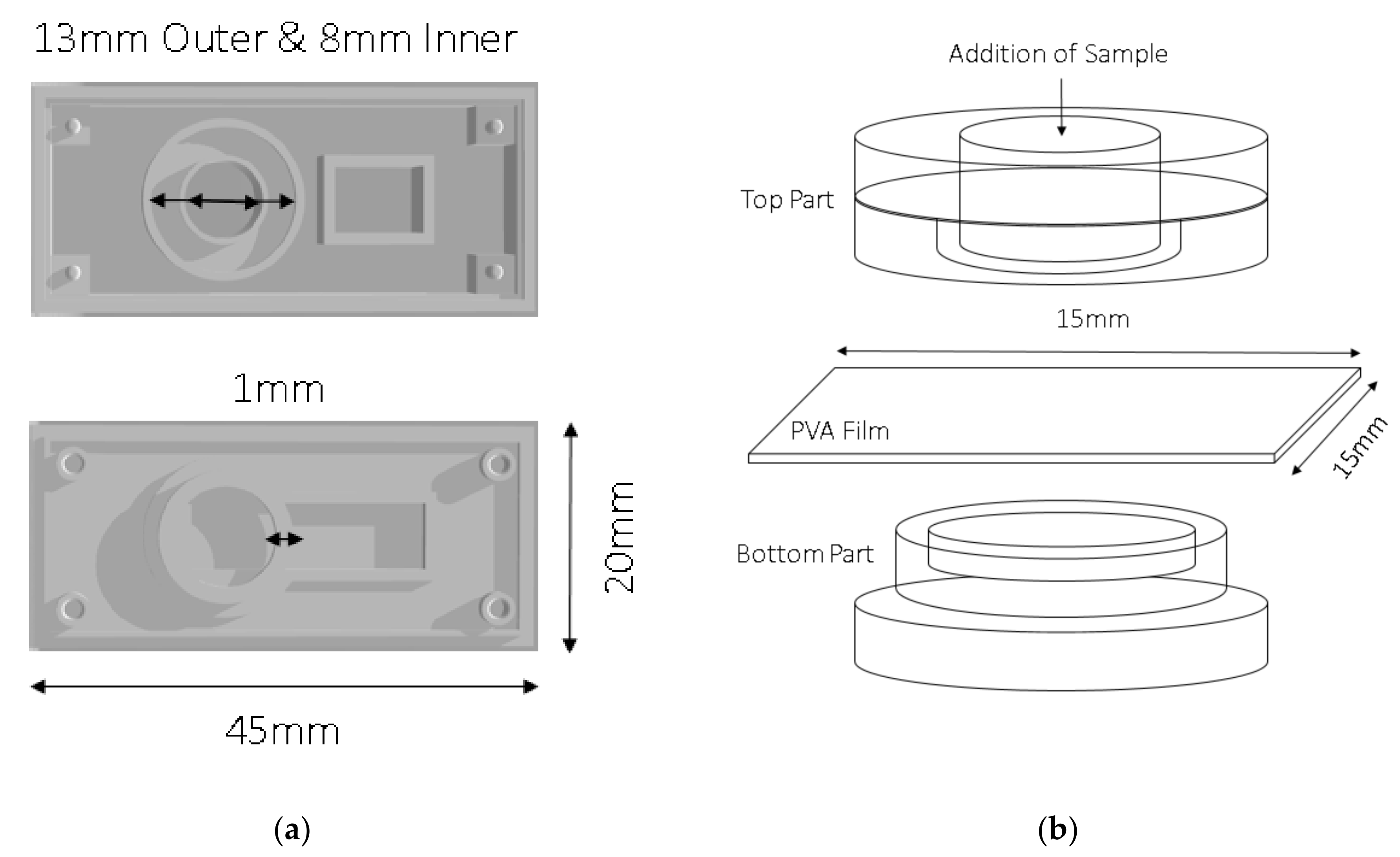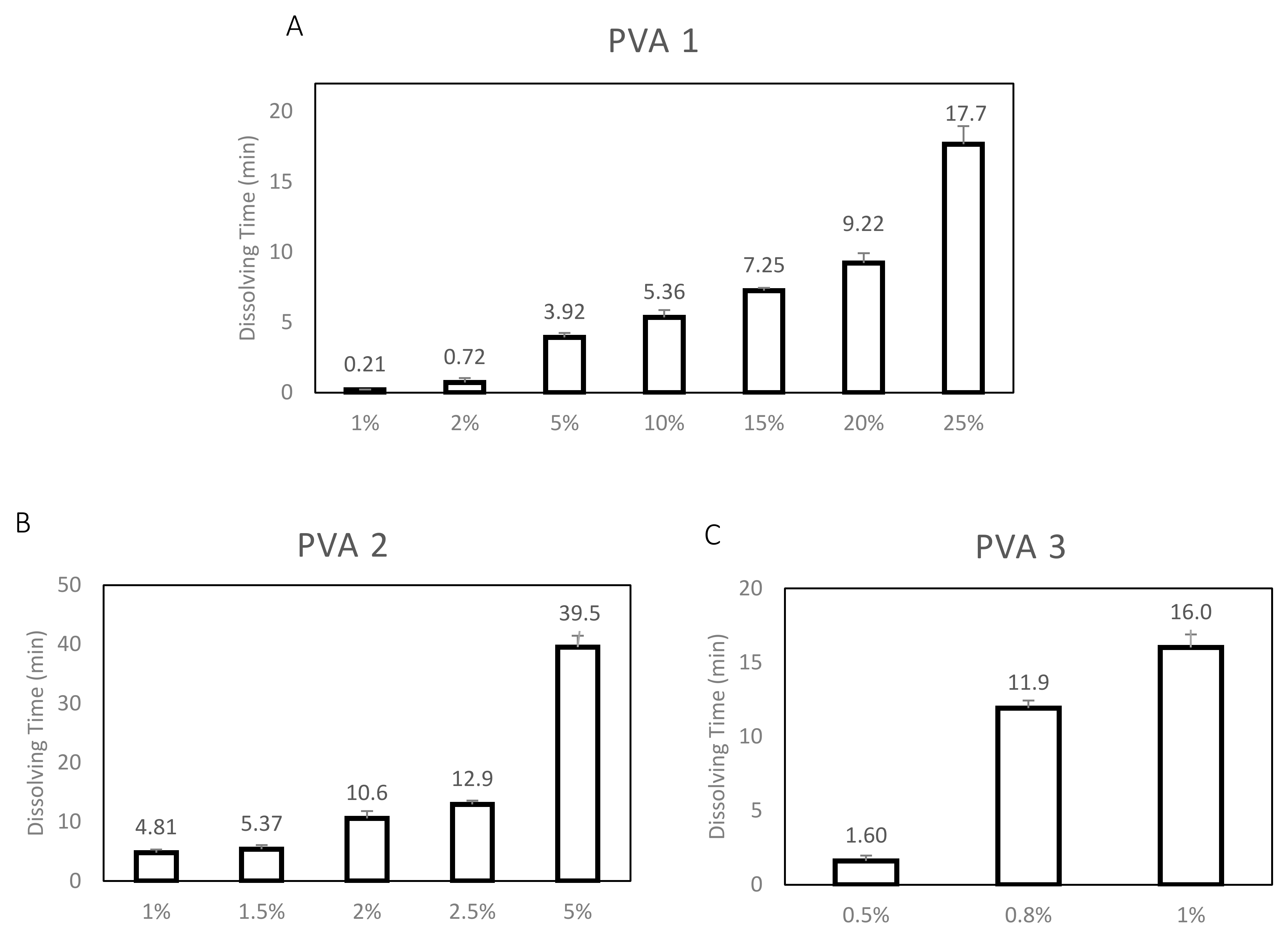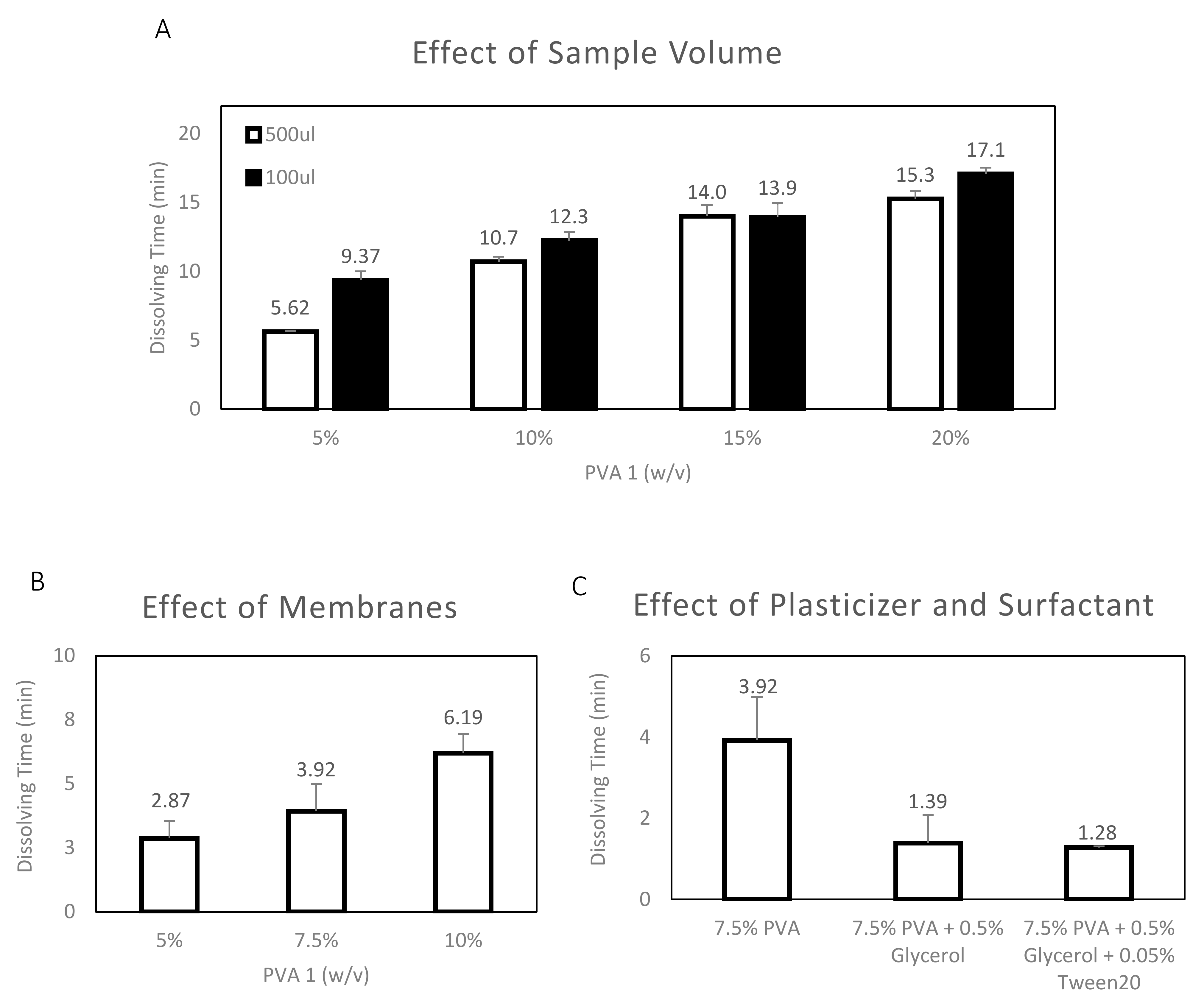Dissolvable Polyvinyl-Alcohol Film, a Time-Barrier to Modulate Sample Flow in a 3D-Printed Holder for Capillary Flow Paper Diagnostics
Abstract
:1. Introduction
2. Materials and Methods
2.1. Materials
2.2. Equipment
2.3. Preparation of Films
2.4. 3D-Printing of Customized Holder
2.5. Determination of Dissolution Time in Water
2.6. Determination of Dissolution Time in the 3D-Printed Holder
2.7. Characterization of Film Weight and Thickness
3. Results and Discussion
3.1. Comparison of PVA 1-3 Films Dissolving Time in Water
3.2. PVA 1 Film Dissolving Time in 3D-Printed Holder
3.3. PVA 1 Film Weight and Thickness Characterization
4. Conclusions
Author Contributions
Funding
Acknowledgments
Conflicts of Interest
References
- Millipore, E. Rapid Lateral Flow Test Strips. 2014, p. 9. Available online: https://www.google.com/url?sa=t&rct=j&q=&esrc=s&source=web&cd=1&cad=rja&uact=8&ved=2ahUKEwjN-br5xNrcAhUN3o8KHTyJD7oQFjAAegQICRAC&url=https%3A%2F%2Fwww.emdmillipore.com%2FWeb-US-Site%2Fen_CA%2F-%2FUSD%2FShowDocument-Pronet%3Fid%3D201306.12550&usg=AOvVaw1G_gcoLiBJGtSZG2_YClC_ (accessed on 1 August 2018).
- Bangs Laboratories, Inc. Lateral Flow Tests. TechNote 303 Rev. #003. 2013. Available online: https://www.technochemical.com/bangs/img/TechNote%20303%20Web.pdf (accessed on 1 August 2018).
- Lenk, G.; Pohanka, A.; Stemme, G.; Beck, O.; Roxhed, N. A disposable chip enabling metering in dried blood spot sampling. In Proceedings of the Micro TAS, Freiburg, Germany, 27–31 October 2013; pp. 281–283. [Google Scholar]
- Meathrel, W.G.; Meyer, N.A.; Barnhart, S.D.; Moritz, C.M.; Full, A.P.; Newsom, S.R.; Robertson, M. Disintegratable Films for Diagnostic Devices. Google Patents US20080299005A1, 2010. [Google Scholar]
- Sridharamurthy, S.S.; Agarwal, A.K.; Beebe, D.J.; Jiang, H. Dissolvable membranes as sensing elements for microfluidics based biological/chemical sensors. Lab Chip 2006, 6, 840–842. [Google Scholar] [CrossRef] [PubMed]
- Deutsch, A.; Platt, H. Self-Contained Assay Method and Kit. Google Patents. U.S. Patent No. 4,522,923, 1985. [Google Scholar]
- Thakur, N.; Bansal, M.; Sharma, N.; Yadav, G.; Khare, P. Overview “a novel approach of fast dissolving films and their patients”. Adv. Biol. Res. 2013, 7, 50–58. [Google Scholar]
- Mandeep, K.; Rana, A.; Nimrata, S. Fast Dissolving Films: An Innovative Drug Delivery System. Int. J. Pharm. Res. Allied Sci. 2013, 2, 14–24. [Google Scholar]
- Particle Science, Inc. Dissolving Films; Techanical brief 2010; Particle Science, Inc.: Bethlehem, PA, USA, 2010; Volume 2013, Available online: https://www.particlesciences.com/docs/technical_briefs/TB_2010_3.pdf (accessed on 1 August 2018).
- Manegold, T.; Zielinski, R. Dissolvable Film and Method of Manufacture. Google Patents WO2005082048A3, 2005. [Google Scholar]
- Muppalaneni, S.; Omidian, H. Polyvinyl Alcohol in Medicine and Pharmacy: A Perspective. J. Dev. Drugs 2013, 2, 112. [Google Scholar] [CrossRef]
- Finch, C.A. Polyvinyl alcohol, properties and applications, CA Finch, Wiley, New York, 1973. 622 pp. $37.50. J. Polym. Sci. Polym. Lett. Ed. 1974, 12, 105–106. [Google Scholar]
- Hassan, C.M.; Peppas, N.A. Structure and Applications of Poly(vinyl alcohol) Hydrogels Produced by Conventional Crosslinking or by Freezing/Thawing Methods. In Biopolymers · PVA Hydrogels, Anionic Polymerisation Nanocomposites; Springer: Berlin/Heidelberg, Germany, 2000; pp. 37–65. [Google Scholar] [CrossRef]
- Harvey, M. Optimization of Nitrocellulose Membrane-Based Immunoassavs; Schleicher & Schuell: Keene, NH, USA, 1991. [Google Scholar]
- Rodda, D.J.; Yamazaki, H. Poly(vinyl alcohol) as a blocking agent in enzyme immunoassays. Immunol. Investig. 1994, 23, 421–428. [Google Scholar] [CrossRef]
- Studentsov, Y.Y.; Schiffman, M.; Strickler, H.D.; Ho, G.Y.; Pang, Y.Y.; Schiller, J.; Herrero, R.; Burk, R.D. Enhanced enzyme-linked immunosorbent assay for detection of antibodies to virus-like particles of human papillomavirus. J. Clin. Microbiol. 2002, 40, 1755–1760. [Google Scholar] [CrossRef] [PubMed]
- Ren, Z.M.; Nie, X.; Ai, S.S. Influence of Blocking Agents on Non-Specific Background of Polystyrene Microbeads in Serum Immunoassay. Adv. Mater. Res. 2013, 641–642, 858–861. [Google Scholar] [CrossRef]
- Anand, U.; Anand, C.V. Enzyme immunoassays—From concept to product development: By S S Deshpande. pp 464. Chapman & Hall, London. 1996 ISBN 0-412-0560101. Biochem. Educ. 1997, 25, 181–181. [Google Scholar]
- Yang, M.-R.; Chen, K.-S. Humidity sensors using polyvinyl alcohol mixed with electrolytes. Sens. Actuators B Chem. 1998, 49, 240–247. [Google Scholar] [CrossRef]
- Andreev, D.V.; Makarshin, L.L.; Parmon, V.N. Sorption and sensing characteristics of polyvinyl alcohol films impregnated with CaCl2. React. Kinet. Catal. Lett. 2003, 80, 181–188. [Google Scholar] [CrossRef]
- Miao, Y.; Liu, B.; Zhang, H.; Li, Y.; Zhou, H.; Sun, H.; Zhang, W.; Zhao, Q. Relative Humidity Sensor Based on Tilted Fiber Bragg Grating With Polyvinyl Alcohol Coating. IEEE Photonics Technol. Lett. 2009, 21, 441–443. [Google Scholar] [CrossRef]
- Gastón, A.; Pérez, F.; Sevilla, J. Optical fiber relative-humidity sensor with polyvinyl alcohol film. Appl. Opt. 2004, 43, 4127–4132. [Google Scholar] [CrossRef] [PubMed]
- Sun, Y.; Lin, Z.; Jiang, X.; Hou, L. Synergism Effect of Surfactant and Inorganic Salt on the Properties of Starch/Poly(Vinyl Alcohol) Film. Starch-Stärke 2018, 70, 1700146. [Google Scholar] [CrossRef]
- Magazine, E.C. Water Soluble Film Technology—Newest Generation of Packaging Solutions. 2018. Available online: http://www.engineeringnews.co.za/article/ecosol-water-soluble-film-technology---newest-generation-of-packaging-solutions-2015-08-05 (accessed on 1 August 2018).
- Kuraray, M. Translating our Science: About Water-Soluble Film. 2018. Available online: https://www.monosol.com/translating-our-science-about-water-soluble-film/ (accessed on 1 August 2018).
- SOLUBLON®, AICELLO. Water Soluble Film. 2018. Available online: http://www.solublon.com/ (accessed on 1 August 2018).
- Guangdong Proudly New Material Technology Corp. Water Soluble PVA Film. 2018. Available online: http://www.proudly.hk/en/product1.htm (accessed on 1 August 2018).
- Sekisui. Selvol Polyvinyl Alcohol. 2018. Available online: https://buypvoh.com/?gclid=CjwKCAjwhqXbBRAREiwAucoo-_EhepNPv3fSHTn30zIj6HQNuiOuCBk26-VDGCDK8RlGXSbKQl1F6RoCshIQAvD_BwE (accessed on 1 August 2018).
- Kochvar, K.A.; Soyez, H.S.M.; Forth, P.J.; Boutique, J.P.; Wagers, R.A.; Wahl, E.H.; Lynch, M.L.; Fisher, W.R. Rapidly Dissolvable Polymer Films and Articles Made Therefrom. Google Patent US20050244444A1, 2002. Available online: https://patents.google.com/patent/US20050244444A1/en (accessed on 1 August 2018).
- Noble, M.W.; Kenmore, N.Y. Polyvinylalcohol Film. U.S. Patent Office 2,419,281, 1947. Available online: https://patentimages.storage.googleapis.com/47/50/5e/853da16e957dac/US2419281.pdf (accessed on 1 August 2018).
- Hassan, C.M.; Trakampan, P.; Peppas, N.A. Water Solubility Characteristics of Poly(vinyl alcohol) and Gels Prepared by Freezing/Thawing Processes. In Water Soluble Polymers: Solutions Properties and Applications; Amjad, Z., Ed.; Springer: Boston, MA, USA, 2002; pp. 31–40. [Google Scholar] [CrossRef]
- Chan, L.W.; Hao, J.S.; Heng, P.W.S. Evaluation of Permeability and Mechanical Properties of Composite Polyvinyl Alcohol Films. Chem. Pharm. Bull. 1999, 47, 1412–1416. [Google Scholar] [CrossRef]
- Chan, H.N.; Tan, M.J.A.; Wu, H. Point-of-care testing: Applications of 3D printing. Lab Chip 2017, 17, 2713–2739. [Google Scholar] [CrossRef] [PubMed]
- Eltzov, E.; Marks, R.S. Colorimetric stack pad immunoassay for bacterial identification. Biosens. Bioelectron. 2017, 87, 572–578. [Google Scholar] [CrossRef] [PubMed]
- Eltzov, E.; Marks, R.S. Miniaturized flow stacked immunoassay for detecting Escherichia coli in a single step. Anal. Chem. 2016, 88, 6441–6449. [Google Scholar] [CrossRef] [PubMed]





© 2019 by the authors. Licensee MDPI, Basel, Switzerland. This article is an open access article distributed under the terms and conditions of the Creative Commons Attribution (CC BY) license (http://creativecommons.org/licenses/by/4.0/).
Share and Cite
Harpaz, D.; Axelrod, T.; Yitian, A.L.; Eltzov, E.; Marks, R.S.; Tok, A.I.Y. Dissolvable Polyvinyl-Alcohol Film, a Time-Barrier to Modulate Sample Flow in a 3D-Printed Holder for Capillary Flow Paper Diagnostics. Materials 2019, 12, 343. https://doi.org/10.3390/ma12030343
Harpaz D, Axelrod T, Yitian AL, Eltzov E, Marks RS, Tok AIY. Dissolvable Polyvinyl-Alcohol Film, a Time-Barrier to Modulate Sample Flow in a 3D-Printed Holder for Capillary Flow Paper Diagnostics. Materials. 2019; 12(3):343. https://doi.org/10.3390/ma12030343
Chicago/Turabian StyleHarpaz, Dorin, Tim Axelrod, Alicia Lu Yitian, Evgeni Eltzov, Robert S. Marks, and Alfred I.Y. Tok. 2019. "Dissolvable Polyvinyl-Alcohol Film, a Time-Barrier to Modulate Sample Flow in a 3D-Printed Holder for Capillary Flow Paper Diagnostics" Materials 12, no. 3: 343. https://doi.org/10.3390/ma12030343
APA StyleHarpaz, D., Axelrod, T., Yitian, A. L., Eltzov, E., Marks, R. S., & Tok, A. I. Y. (2019). Dissolvable Polyvinyl-Alcohol Film, a Time-Barrier to Modulate Sample Flow in a 3D-Printed Holder for Capillary Flow Paper Diagnostics. Materials, 12(3), 343. https://doi.org/10.3390/ma12030343






